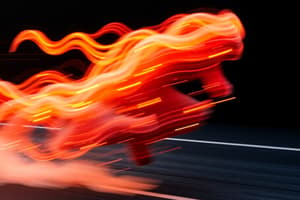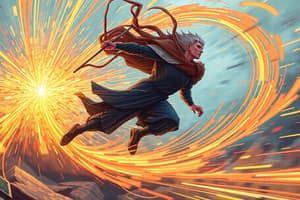Podcast
Questions and Answers
What is the unit of measurement for force?
What is the unit of measurement for force?
- Kilograms per meter
- Newtons (N) (correct)
- Pascals (Pa)
- Pounds per square inch (psi)
What type of force occurs when two objects are not in physical contact?
What type of force occurs when two objects are not in physical contact?
- Contact force
- Tension force
- Non-contact force (correct)
- Normal force
What is the force that opposes motion between two surfaces in contact?
What is the force that opposes motion between two surfaces in contact?
- Friction (correct)
- Gravity
- Normal force
- Air resistance
What is the formula to calculate pressure?
What is the formula to calculate pressure?
What happens to pressure when the surface area of an object decreases?
What happens to pressure when the surface area of an object decreases?
What is the force that causes an object to change its motion or shape?
What is the force that causes an object to change its motion or shape?
What is the force of attraction between two objects with mass?
What is the force of attraction between two objects with mass?
Flashcards are hidden until you start studying
Study Notes
Science: Force and Pressure
Force
- A push or pull that causes an object to change its motion or shape
- Measured in Newtons (N)
- Can be either:
- Contact force: occurs when two objects are in physical contact (e.g. friction, normal force)
- Non-contact force: occurs when objects are not in physical contact (e.g. gravity, magnetic force)
Types of Forces
- Gravity: force of attraction between two objects with mass
- Friction: force that opposes motion between two surfaces in contact
- Normal force: force exerted by a surface on an object that is in contact with it
- Tension: force exerted by a stretched string or wire
- Air resistance: force that opposes the motion of an object through the air
Pressure
- Force per unit area
- Measured in Pascals (Pa) or pounds per square inch (psi)
- Calculated using the formula: Pressure = Force / Area
- Depends on:
- Force applied
- Surface area of the object
Effects of Pressure
- Increases with:
- Increase in force
- Decrease in surface area
- Decreases with:
- Decrease in force
- Increase in surface area
- Examples:
- High pressure at the bottom of a deep swimming pool
- Low pressure at high altitudes
Science: Force and Pressure
Force
- Defined as a push or pull that causes an object to change its motion or shape
- Measured in units of Newtons (N)
- Classified into two types:
- Contact forces: occur when two objects are in physical contact (e.g. friction, normal force)
- Non-contact forces: occur when objects are not in physical contact (e.g. gravity, magnetic force)
Types of Forces
- Gravity: a force of attraction between two objects with mass
- Friction: a force that opposes motion between two surfaces in contact
- Normal force: a force exerted by a surface on an object that is in contact with it
- Tension: a force exerted by a stretched string or wire
- Air resistance: a force that opposes the motion of an object through the air
Pressure
- Defined as force per unit area
- Measured in units of Pascals (Pa) or pounds per square inch (psi)
- Calculated using the formula: Pressure = Force / Area
- Influenced by:
- Force applied
- Surface area of the object
- Greater pressure results from:
- Increasing the force
- Decreasing the surface area
- Lower pressure results from:
- Decreasing the force
- Increasing the surface area
Effects of Pressure
- Examples of high pressure:
- At the bottom of a deep swimming pool
- Examples of low pressure:
- At high altitudes
Studying That Suits You
Use AI to generate personalized quizzes and flashcards to suit your learning preferences.




